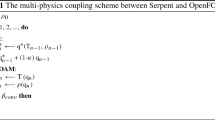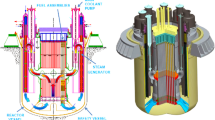Abstract
A new method of Serpent–OpenFOAM coupling is developed as a multi-physics model for Advanced Lead Fast Reactor Demonstrator. The reactor core is simulated in Serpent, a continuous-energy Monte Carlo reactor physics code for neutronic analysis. A three-dimensional geometry is modeled for the calculation of neutronic parameters of the reactor initial core operation. The calculated parameters are evaluated with a good agreement compared to the available reference. The fuel assembly with the maximum power is pinpointed in order to be used for thermal-hydraulic analysis. A thermal-hydraulic model is developed to perform computational fluid dynamics calculation using OpenFOAM software, with an application of a heat conjugate transfer solver written in C++ language. A symmetric one-six of the fuel assembly with the highest power is considered in order to reduce the time of calculation. A multi-physics approach is adopted to map Serpent and OpenFOAM coupling for neutronic and thermal-hydraulic analysis. Moreover, a procedure is implemented in order to evaluate the convergence while coupling Serpent and OpenFOAM. With the implementation of multi-physics model, the maximum temperature of the fuel and coolant is investigated in order to observe any malfunctions. The results show that the coolant and the fuel temperature limits for the ALFRED’s initial core are well preserved for the fuel assembly with the highest power.
























Similar content being viewed by others
Abbreviations
- \(c_{p}\) :
-
Heat capacity (\(\hbox {J\,kg}^{-1}\,\hbox {K}^{-1}\))
- \(D_{k}\) :
-
Closure coefficient for \(k-\varepsilon \) (–)
- \(D_{\varepsilon }\) :
-
Closure coefficient for \(k-\varepsilon \) (–)
- g :
-
Gravity field (\(\hbox {m\,s}^{-2}\))
- I :
-
Identity tensor (–)
- k :
-
Turbulent kinetic energy (\(\hbox {m}^{2}\,\hbox { s}^{-2}\))
- \({L}_{\mathrm{T}}\) :
-
Turbulence length scale (m)
- \(N_{\mathrm{f}}\) :
-
Number of fuel elements (–)
- p :
-
Pressure (Pa)
- P :
-
Power (W)
- \({P}_{\mathrm{r}}\) :
-
Relative power variation (–)
- \(P_{\mathrm{rel}}\) :
-
Relaxed power distribution (W)
- s :
-
Number of neutrons (–)
- T :
-
Temperature (K)
- u :
-
Velocity field (\(\hbox {m\,s}^{-1}\))
- \({U}_{0}\) :
-
Inlet velocity (\(\hbox {m\,s}^{-1}\))
- \(\alpha \) :
-
Addition under relation factor (–)
- K :
-
Thermal conductivity (\(\hbox {w\,m}^{-1}\,\hbox {k}^{-1}\))
- \(\varepsilon \) :
-
Turbulent dissipation rate (\(\hbox {m}^{2}\,\hbox {s}^{-3}\))
- \(\mu _{\mathrm{T}}\) :
-
Turbulent dynamic viscosity (Pa s)
- \(\mu \) :
-
Dynamic viscosity (Pa s)
- \(\rho \) :
-
Density (\(\hbox {kg\,m}^{-3}\))
References
A. Alemberti, D. De Bruyn, G. Grasso, L. Mansani, D. Mattioli, F. Roelofs, Presented at the FR13-IAEA International Conference on Fast Reactors and Related Fuel Cycles: Safe Technologies and Sustainable Scenarios, Paris (2013) (unpublished)
G. Grasso, C. Petrovich, D. Mattioli, C. Artioli, P. Sciora, D. Gugiu, G. Bandini, E. Bubelis, K. Mikityuk, Nuclear Eng. Des. 278, 287 (2014)
N. Cerullo, G. Lomonaco IV, Nuclear Fuel Cycle Science and Engineering, ed. by I. Crossland (Woodhead Publishing: Cambridge, UK, 2012), p. 333
C.F. Smith, L. Cinotti, Handbook of Generation IV Nuclear Reactors (Elsevier, Amsterdam, 2016), p. 119
D. Chersola, G. Lomonaco, R. Marotta, G. Mazzini, Nuclear Eng. Des. 273, 542 (2014)
D. Chersola, G. Lomonaco, G. Mazzini, Presented at the 2014 22nd International Conference on Nuclear Engineering (2014) (unpublished)
OpenFOAM, in www.openfoam.org (2017)
G. Lomonaco, W. Borreani, M. Bruzzone, D. Chersola, G. Firpo, M. Osipenko, M. Palmero, F. Panza, M. Ripani, P. Saracco, Therm. Sci. Eng. Prog. 6, 447 (2018)
J.F. Fernández, Universitat Politècnica de Catalunya (UPC) (2012)
J.J. Carbajo, G.L. Yoder, S.G. Popov, V.K. Ivanov, J. Nuclear Mater. 299(3), 181 (2001)
D. Baron, Presented at the Proceedings of Seminar on Thermal Performance of High Burnup LWR Fuel (1998) (unpublished)
J. Fink, J. Nuclear Mater. 279(1), 1 (2000)
P. Kirillov, Institute for heat and mass transfer in nuclear power plants (Obninsk, 2006)
V. Sobolev, P. Schuurmans, G. Benamati, J. Nuclear Mater. 376(3), 358 (2008)
G. Grasso, C. Petrovich, K. Mikityuk, D. Mattioli, F. Manni, D. Gugiu, Presented at the Proceedings of the IAEA International Conference on Fast Reactors and Related Fuel Cycles: Safe Technologies and Sustainable Scenarios (2013) (unpublished)
D. Lamberts, presented at the SCK \(\cdot \)CEN/PSD, LEADER Project Meeting, Bologna, 25th October (2011) (unpublished)
B.E. Launder, D.B. Spalding, Comput. Methods Appl. Mech. Eng. 3(2), 269 (1974)
Y. Philipponneau, J. Nuclear Mater. 188, 194 (1992)
C. Duriez, J.-P. Alessandri, T. Gervais, Y. Philipponneau, J. Nuclear Mater. 277(2), 143 (2000)
J. Leppänen, VTT Technical Research Centre of Finland 4, (2013)
T. Viitanen, J. Leppänen, Nuclear Sci. Eng. 177(1), 77 (2014)
J. Dufek, W. Gudowski, Nuclear Sci. Eng. 152(3), 274 (2006)
G. Rimpault, D. Plisson, J. Tommasi, R. Jacqmin, J. Rieunier, D. Verrier, D. Biron, presented at the Proceedings of International Conference on PHYSOR (2002) (unpublished)
A. Weisenburger, A. Heinzel, G. Müller, H. Muscher, A. Rousanov, J. Nuclear Mater. 376(3), 274 (2008)
Acknowledgements
The authors wish to express their thanks to the management and staff of CeSNEF-Nuclear Engineering Division, Department of Energy, Politectico di Milano, Milano, Italy, for their support and contribution.
Author information
Authors and Affiliations
Corresponding author
Rights and permissions
About this article
Cite this article
Jamalipour, M., Cammi, A. & Lorenzi, S. A coupled neutronic and thermal-hydraulic model for ALFRED. Eur. Phys. J. Plus 135, 328 (2020). https://doi.org/10.1140/epjp/s13360-020-00328-5
Received:
Accepted:
Published:
DOI: https://doi.org/10.1140/epjp/s13360-020-00328-5




